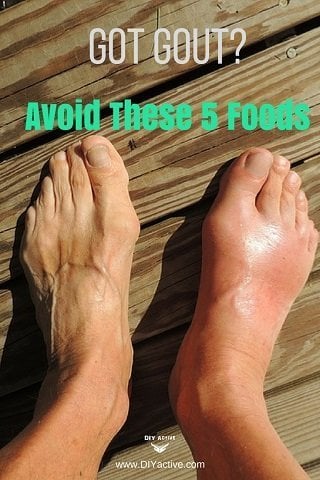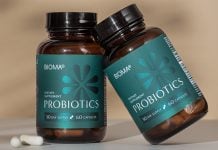
Avoid these Foods if You Have Gout
Our roundup of the 5 worst foods for gout—the worst offenders also happen to be common in Western diets, so you’ve got your work cut out for you! If you’re here, we can probably assume that you know gout is a type of inflammatory arthritis that develops when there’s too much uric acid in the blood.
The uric acid forms needle-like crystals that build up in the big toe joint causing intense pain, swelling, and stiffness. It is the most common form of inflammatory arthritis for men, although it also occurs in some women who are postmenopausal.
Thankfully, gout is a manageable condition and there are several things you can do to help lessen its symptoms. In addition to medications that treat the inflammation and prevent the formation of uric acid crystals, it also helps if you can avoid these top five foods which are bad for gout.
5 Worst Foods for Gout
#1 Sugar
Sugar is associated with many health problems including obesity, high blood pressure, diabetes, heart disease, and cancer. Turns out that sugar is also bad for gout! The fructose found in most sugary drinks increases uric acid levels, causing them to harden and crystallize. That’s when the debilitating gout attack occurs.
Unfortunately, most of our food today contains lots of sugars. You have to read the label to make sure it doesn’t have high fructose corn syrup, sucrose, corn syrup, or other types of artificial sugars which are all equally bad for gout.
Sugar addicts need not worry. If you stay away from sugar for two weeks, your body becomes less reactive to it.
This means you don’t crave it as much as you used to. On the flip side, you want to be careful with eating too much sugar since it’s so easy to get desensitized to it. This means that the more sugar you eat, the better your body becomes at absorbing it. That’s something you want to avoid if you have gout.
#2 Alcohol
Alcohol, especially beer, is very high in purines. It’s no question why it’s bad for your gout.
One study found that patients who drank 12 ounces of beer daily were almost two times more likely to have gout than those who didn’t drink alcohol.
You also need to remember that corporations who manufacture alcohol can get away with adding harmful ingredients to their recipe without reporting it on the label. This is because they have lobbied the industry for years to keep it that way.
Guilty culprits include Corona beer which contains GMO corn syrup, Newcastle beer which has caramel coloring made from ammonia, and Michelob Ultra beer which has GMO dextrose. Brands like Budweiser and Miller Lite have also been found to contain GMO corn and corn syrup.
If you must have an alcoholic beverage, opt for wine or hard liquor. Wine provides some health benefits when taken moderately while hard liquor does not have the same severe effects as beer. For beer lovers, consider organic beers that are brewed locally and steer clear from US-produced beers since those tend to have GMOs in them.
#3 Seafood 
Did you know that lobster was once considered to be a poor man’s food? Poor families had easy access to seafood due to its high abundance, especially to those who lived near water. It wasn’t until the late 1800s that seafood became popular and was being served at high-end restaurants.
There is a good reason why wealthy families shunned lobsters in the past: it’s one of the dirtiest foods you can eat as it lives off waste sitting at the bottom of the ocean. Shrimp is another scavenger that lives by eating dead creatures’ flesh.
One study found that men who ate seafood increased their risk of developing gout by almost two times. Each additional serving of seafood weekly increased the risk by 7%. When you eat these kinds of seafood, you are eating waste and other pollutants these creatures consumed in the sea—not good for your gout.
#4 Tomatoes
Tomatoes are very nutritious, but try to limit your intake of them since they have a very low pH which can trigger gout. Other variations of tomato like canned tomato, tomato paste, and tomato juice generally have a pH level below 5 which makes it very acidic.
If you want to eat tomatoes, consider eating Gazpacho soup instead since it contains 50% fewer tomatoes. It might even help lower your uric acid levels. But as for all other tomatoes, they should be avoided as much as possible.
#5 Meat
Meat has been associated with a wide range of chronic diseases including heart diseases, type 2 diabetes, certain types of cancer, and metabolic syndrome.
Certain types of meat should be avoided for gout since they are known to be high in purines. This includes organ meats like brains, liver, kidney, and animal heart.
Just stay away from any kind of organ meat since they contain a lot of toxins accumulated from the animal’s body. You also want to avoid processed meat like hotdogs and bacons since those tend to cause health problems later on.
You may want to consider going for a plant-based diet. Whole plants provide a range of benefits to the body, keeping it nourished and sustained. It also goes through the body more easily compared to meat. The more meat you eat, the more your kidney has to work just to flush out the waste, thus increasing your risk of increasing your uric acid levels.
If you must eat meat, opt for fish since it’s a healthier source of protein and contains little fat. You also want to keep your portion sizes down. It should be no bigger than the palm of your hand. Other meats that you can eat in moderation include beef, chicken, turkey, lamb, pork, duck, mussels, prawns, shrimp, and scampi.
The hierarchy for choosing which meat to eat for gout should be fish first, then poultry, then red meat.
Wrap-Up
As a gout sufferer, it’s important that you learn what your personal limit for certain foods is. By trial and error, you can identify which foods cause you the most problems and avoid them as much as possible. Finally, it is important to follow a proper gout diet in order to further prevent your condition from worsening.
What foods do you mainly avoid for your gout? Share them in the comments below!
- Gout Diet: 5 Foods to Avoid With Gout - January 10, 2018



